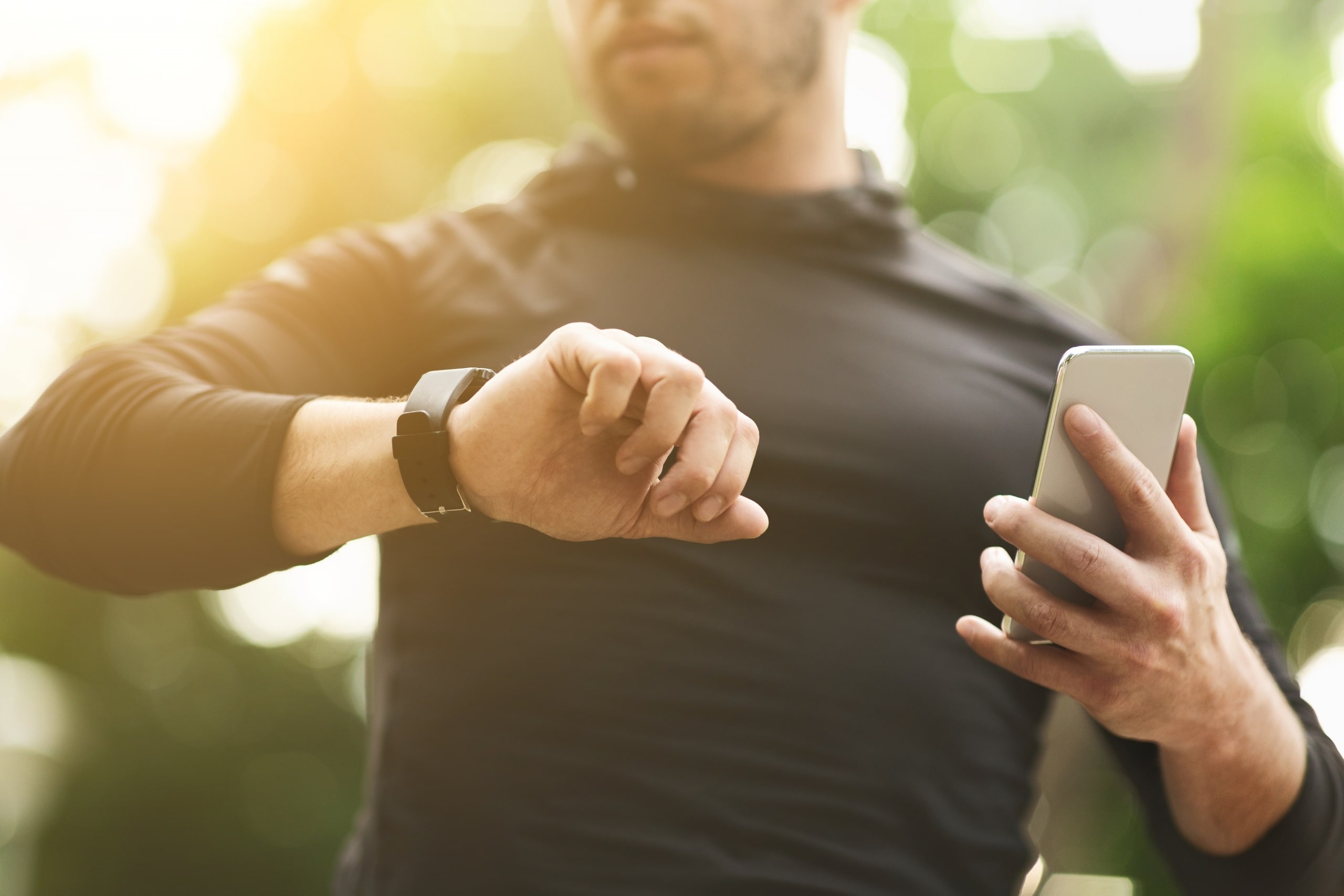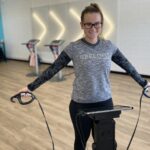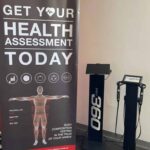
Tracking Body Measurements: It’s all about progress, not perfection and let’s face it – standing on a set of bathroom scales daily, weekly or fortnightly is 100% loathsome. And not just because it’s frustrating when the numbers don’t move, but because that system of measurement is completely outdated and doesn’t reveal how healthy you actually are.
We love sharing amazing transformation stories of everyday people who have achieved incredible results through sheer will and determination, and when you read through them you’ll notice they all share a singular commonality – they each keep track of their progress.
So what are some of the best ways you can do that too? There are a few different resources and tools you can use, but it’s up to you which one you think will work best for you.
Tracking Along with Trackers and Apps
Dedicated fitness trackers like sports watches can help you move more, sleep better and improve your overall health. But sometimes they can be a little out of our budget, so one of the best ways to get started is by downloading an app that counts your steps as well as all those calories burnt. This requires absolutely no investment, and is perfect for those starting their health and fitness journey.
Pros
- You can set your notification settings in your app of choice to remind you to be active when it takes notice you’ve been immobile for too long.
- Many apps allow you the ability to connect with friends and family who also have the app, so you’re more likely to achieve your goal when surrounding yourself with like-minded people who can support you.
- You can set individual goals and programs in most fitness trackers and apps.
Cons
- The bottom line is that apps are great at counting steps when you carry your smartphone in your pocket while walking, but a large number of the population don’t do that. The step count is likely to be less than a hip or ankle pedometer you’d wear.
- It’s easy to judge ourselves when we become fixated on constantly beating our personal bests from previous days.
Work The Camera, Work It!
As much as you might dislike the thought of having your picture taken, the differences you’ll see in before and after photos can motivate you to even higher end goals. They say a picture is worth a hundred words, and when it comes to progress this is a great way to get a visual reminder of how far you’ve come.
Pros
- Pictures add valuable and honest visual elements to your results, giving you a better idea of how your body is looking.
- Before and after photos make for an amazing transformation story, and you will not only be improving your life, but you may make an impact on someone else’s.
Cons
- Unfortunately, it can be quite easy to fake a before and after series of photos, so what you see from others may not necessarily be true.
- Taking shots from certain angles may be deceiving, so it’s important to take pictures in the same light at the same time of day at the exact same angle as previously.
- Day-to-day changes are difficult to measure.
A Pinch and A Punch For Your Skinfolds
Measuring skinfolds for determining body fat percentages is one of the oldest and most common methods of determining your body composition, but the numbers are estimates – mostly because they require a bit of mathematics, and accuracy depends on the quality of calipers.
Pros
- A set of skinfold calipers may only set you back a few dollars, so the investment is minimal, but you’re still expected to pay a few hundred dollars for ones that are the most accurate and durable.
- You can do your skinfold measurements in the comfort of your own home.
Cons
- Since using the calipers can be difficult, skinfold measurements may not be the best choice for assessing fat percentages.
- Skinfold testing is becoming somewhat of an ancient art form, with most personal trainers today using electrical impedance methods (like the Evolt 360 body composition analyzer).
Body Measurements Via Tape Measure
How can you know if you’re making progress if the changes are happening but you can’t measure them and the scale isn’t moving? Knowing your scale weight is useful, but it doesn’t provide a whole picture. Taking body measurements with a simple tape measure is something everyone can do, and doesn’t require any fancy equipment.
Pros
- Taking your measurements can help reassure you that things are happening, even if you’re not losing fat exactly where you want to just yet.
- It’s the cheapest method used to determine body composition with tape measures sold for as little as $2.
- Measurements can tell you which muscle groups are responding to your fitness regime and which ones need to be attacked in a different way.
Cons
- If you’re not knowledgeable on the exact anatomical sites for each measurement, the reliability of those numbers decreases.
- Girth measurements can fluctuate depending on fluid retention and changes in glycogen content.
- A tape measure is unable to tell you the difference between fat gain/fat loss versus muscle gain/muscle loss.

Body Scanning With An Evolt 360
The Evolt 360 body composition analyzer works by sending tiny electrical impulses through the body and measuring how quickly those impulses return. Known as a bioelectrical impedance device, machines like the Evolt 360 calculate dozens of body measurements so you can get an accurate figure on body fat percentage plus lean body mass, subcutaneous fat mass, protein levels and so much more.
Pros
- Although bioelectrical impedance devices work by sending electrical impulses, users don’t feel a thing.
- They are incredibly easy to use and you get a reading of all your measurements in just 60 seconds.
- The measurements are as close to accurate as you can possibly get thanks to the Evolt 360 being scientifically validated.
Cons
- Bioelectrical impedance devices are mostly found at gyms and lifestyle centres, so if your centre doesn’t have one for you to use, you have to source one externally and pay to use it.
- It’s recommended that body scans be done at the same time of day as previous scans to avoid changes in hydration levels, meal times, recent exercise and room temperature.
Hydro-what?
Hydrostatic weighing is a fancy way of saying ‘underwater weighing’, comparing a person’s normal bodyweight on land to his or her bodyweight while completely submerged in water. Body composition is calculated by using the two bodyweight numbers and the density of the water.
Pros
- Hydrostatic weighing has been well studied, with the technique using tried and true variables that feature a low percentage of error. Some experts have referred to it as the gold standard of measuring body composition.
- It takes just 15 minutes to conduct a hydrostatic weigh test.
Cons
- You’ll need to find a lab or performance centre for this technique, so it’s a bit inconvenient.
- When doing the test, you’ll have to forcefully exhale as much air out of your lungs as possible to reduce potential for error and sit submerged completely underwater, which can be uncomfortable for some people.
- This method is not suitable for those suffering cardiac issues or for the elderly.
X-Ray Beam Exposures
Another machine-style way of measuring body composition is via a DEXA scan, which exposes the user to x-ray beams to develop readings for bone mineral density, body fat plus other measurements.
Pros
- A DEXA scan can inform you how your fat and lean mass is distributed around your body.
- The method is relatively quick but can set you back a bit in money per scan.
Cons
- DEXA scans cannot differentiate between visceral and subcutaneous fat.
- They are great for those people who might be experiencing bone loss because the scan tests bone density, which can help diagnose conditions like osteoporosis and osteopenia, but not necessarily accurate fat levels and percentages.
- Machines are not available around-the-clock, so you’d have to make an appointment.
Regardless of which way you to decide to track your progress in your health and fitness journey, resist the urge to do it on a daily or weekly basis. Results take time, and the first few weeks should be focused on implementing good habits and noticing how great you feel from all the changes.
These are all incredibly useful tools to help you along the way, but remember – body composition is just one metric on the road to improved health and fitness.
To learn more about your body and for personalized macronutrient and supplement recommendations Download the Evolt Active app and search for your nearest Evolt 360 Body Composition Scan location.
For more information about purchasing an Evolt 360 for your business visit www.evolt360.com/contact or request an information pack below.

